Slum TV
2007
Slum TV_01_Production Image_2007_(c)Slum TV-17
Collaborative Content And Practising The Ngo Aesthetic - Sam Hopkins
Excerpt from Distributed: Co-producing Narratives Of Belonging in Nairobi's Eastlands. PhD thesis, UAL, Supervisors: N. Cummings, J. Bajorek
Representing Mathare Valley
In 2004, the first time I went to Mathare, it was not there. Officially speaking, that is. On maps of the city there was simply an empty space titled ‘Mathare Valley’, with no indication of the houses, streets, businesses and community of thousands of people that lived there.(1) Whilst the Kenyan government did not officially recognise Mathare as an inhabited neighbourhood, Non Governmental Organisations (NGOs) and aid organisations such as UNHABITAT did. But they could not agree on what Mathare actually constituted. Terms ranged from the euphemistic (informal settlement) to the direct (slum) to the more ambiguous (community). And if there was a lack of clarity over how to describe Mathare, there was active disagreement over how many people it consisted of. Most organisations based there, referred to a resident population of about half a million people, but when the National Census finally acknowledged Mathare in 2009, the official count of the population was just under ninety thousand.(2)
This representational deficit of Mathare was further echoed in its media representation. In 2004 there was no local media organisation based in the neighbourhood and any news stories were produced either by national or international media groups or NGOs and humanitarian organisations. As Mathare was not officially mapped and can be dangerous, access to locations, people and stories was difficult.(3) Typically journalists would enter Mathare to do a specific story, and generally with a “fixer”—a local who helped the journalist navigate and negotiate the area. These challenges of access amplified a restricted imagination of what the neighbourhood constituted. The overwhelming majority of stories perpetuated a clichéd image of the neighbourhood as a dangerous ghetto.(4) Alternatively, there were the stories of hope and change, often with the implicit or explicit support of NGOs and aid organisations. These are important narratives, as they counter a clichéd rendition of Mathare as a space of pure danger, but they further fuelled a simplistic, two-dimensional representation of a complex and nuanced world.(5)
Spanning these representational realms is the recurring exclusion of the inhabitants of Mathare from their own representation. From defining how they were shown on a map, to registering their own information in a census, to deciding how to designate their neighbourhood and how to represent themselves in images and text.(6) This exclusion from the processes of physical representation both exacerbated, and was mirrored by, an exclusion from their political representation. A populace that lives in a neighbourhood, which is not even on the map, whose denomination or size cannot be agreed upon, and who are not in charge of their own image cannot constitute an effective block to engage in the struggle for basic rights and amenities. This tenuous existence is exemplified by the predominant shack architecture that can be, and often is, without warning, demolished by the state.(7)

Slum TV_01_Production Image_2007_(c)Slum TV-17
Mathare - A Personal Perspective
When I first visited Mathare it was during the rainy season. The dirt streets and narrow alleys that work their way between the corrugated aluminium shacks were thick with mud. Running alongside these thoroughfares, often precariously separated from them, is an intricate network of hand-dug channels conducting sewage to the river below. When it rained it was cold and damp, but as soon as the equatorial sun came out, it became very hot, the air thick with the aroma of rotting rubbish.
Extremes permeate Mathare. It can be an incredibly violent place. Located in a valley, it is well-suited to concealing certain illegal activities, such as brewing chang’aa (moonshine liquor) and selling heroin. These economies nurture the existence of a network of gangs, who compete for territory and resources in the neighbourhood. Yet, this criminal activity has ambiguous qualities. For many of the young men involved,
this is work, and for many of the inhabitants implicated in the protection and extortion schemes, they are far more preferable than the police.(8) A number of renegade, undercover police officers patrol Mathare and operate a shoot to kill policy with seeming total impunity.(9) But simultaneous to, and alongside this brutal regime, Mathare is a place of extreme compassion and solidarity; of poor mothers looking after and feeding children; of neighbours who are even poorer; of broke young men coaching football teams for little or no money; of artists and musicians, training young pupils for free.
I found it very difficult to perceive and describe the complexities of the neighbourhood. On a physical level, it is clearly a slum, an area of improvised building, rudimentary infrastructure and poor sanitary conditions.(10) But within this basic, temporary built environment my impression was that this was a place where people lived, not just where they survived. The main streets in the valley are lined with everyday businesses doing a brisk trade; butchers grilling meat, bars serving drinks, vegetable stalls selling fresh tomatoes, spinach and kale, tailors and hairdressers, to name but a few.I had not expected to encounter a thriving economy in Mathare, but the longer I spent there the more I sensed the extensive nature of the financial transactions within the neighbourhood.
A market logic governed everything from the real estate (the huts closer to the river have a lower rent than the huts at the top of the valley) to the heroin bazes (after shooting up you can either sleep at the table for 20 Kenya Shillings (KES), sleep sideways on a shared bed for 40 KES or sleep on your back on a shared bed for 50 KES.(11)
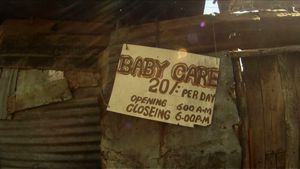
Slum TV_01_Production Image_2007_(c)Slum TV-18
In Planet of Slums, Mike Davies argues that the huge presence and proliferation of slums on a global scale (an estimated one billion people live in slums worldwide) is both a consequence of specific Neoliberal policies, imposed on the South through Structural Adjustment Policies (SAPs) and the International Monetary Fund (IMF) and a characteristic of a broad Neoliberal system.(12) I had the sensation that Mathare was permeated by a Neoliberal logic, that it was an extension of this system as much as a result of it.(13)
Slum TV As A Mode Of Working Together
Slum TV is a participatory media collective based in Mathare that I co-initiated in 2007 with Julius Mwelu, Fred Otieno, Alex Nikolic and Lukas Pusch. Although we registered it as a Trust the following year, we always referred to Slum TV as a participatory collective. In doing so we were consciously allying ourselves with a rich heritage of visual practice and a broad, contemporary field of socially-engaged artworks.(14) I mentioned in the introduction that participation is evoked by artists to describe a spectrum of modes of ‘working together’ ranging from humble gestures (eating soup together in a gallery), to sustained social work with a particular community (engaging drug addicts in recycling workshops) to exploitative acts that meditate on the limits of participation itself (being paid to have your hair bleached).(15) As project initiators we came from different backgrounds and hence also had a broad range of influences for what we understood as participation.(16)
We discussed and referenced a wide range of artworks, a selective sample would include the practice of Thomas Hirschorn, particularly his monument series, the interventions of Jeremy Deller, particularly The Battle of Orgreave (2001), the internet TV of Superflex, Park Fiction (1994-) by Christoph Schäfer et al and the poetic public performances of Francis Alÿs.(17) These works all employ differing types of participation but they are typified by; artists working beyond traditional ‘exhibitionary’ spaces to engage with communities and constituencies who can be broadly understood as marginal and develop a work together which has an emancipatory agenda and impact.
We approached this broad territory of concern (working with alternative spaces, various communities and social impact) with the core criterion of the project, to enable a counter-representation of Mathare to develop from within the community itself, as our governing principle. Being clear about this elemental intention of the project was essential, as we became quickly aware that in developing a project like Slum TV in a context like Mathare, we were dealing with a constantly changing and unpredictable situation. This ranged from violent situations flaring up that affected stories that we wanted to document, to members not turning up due to personal or financial problems, or sometimes having to move office with a few hours notice.
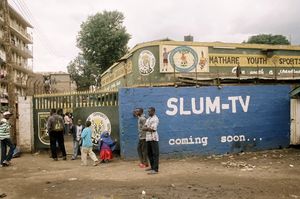
Slum TV_01_Production Image_2007_(c)Slum TV-3
Hence, in some situations our aspirations for participation were modulated by a necessity to be practical and pragmatic. A good example is the fact that we registered as a Trust - a legal body that places the organisational and financial responsibility with the trustees, not with the members. Hence, de jure, Slum TV was not a participatory institution. This was a decision that we took in order to navigate a notoriously complicated Kenyan bureaucracy, register an organisation and start working. However, we found four trustees that shared our belief in the importance of a counter-narrative of Mathare which young people from Mathare were free to develop as they chose, and who trusted us to run the organisation responsibly. Thus, de facto, Slum TV was a participatory organisation.
It also became clear that, although we understood ourselves to be a collective—a loose non-hierarchical organisation, there were different subsections within the collective. The project initiators, the members of Slum TV and the trustees of the legally-registered entity were three groups with different roles and responsibilities. The initiators applied for, managed and accounted for funds to run the project, the members received funds in the form of a stipend for producing the small moving image clips and the trustees were legally liable for the correct disbursement of these funds. In terms of the managing, and responsibility of the finances of the project, there was a clear hierarchy. Seen from the perspective of participation, it becomes clear that there were different types of participation in the project. Slum TV was characterised by a practical approach to bureaucracy with the overall intention of the project to enable a counter- representation of Mathare to develop from within the community itself.
This is by no means to suggest that the only participatory elements of the project were the editorial meetings and the production of content. We were constantly trying to make the organisation as horizontal as possible. If there were conflicts within the organisation, for example, if a member was caught stealing, then we would meet to collectively agree on a fair outcome.(18) We spent many months collectively developing a ‘members handbook’, a kind of constitution for the organisation discussed and designed by the members themselves. And it is important to remember that this was not a static situation; the roles that everyone had within the organisation were dynamic and in flux. Within two years, one of the members was starting to manage the accounts and within five years, the entire project was run by former members.(19)
Although there were three distinct groups within Slum TV, there was a fluid nature to the power structure within the organisation that was evident in the day-to- day operations of the project, and how it managed to function.
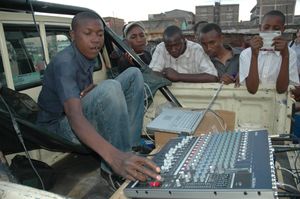
Slum TV_01_Production Image_2007_(c)Slum TV-6
For instance, it was the members who managed to organise our night time screenings in Mathare by using their interpersonal networks to negotiate our use of a rare piece of public space informally managed by a football coach called Austin. This arrangement, and his custodianship of the screenings and our equipment, would have been impossible for either the trustees or the initiators to organise as these were networks that we did not share.
Participation And Editorial Control
The practical centre, and sacred cornerstone, of Slum TV were the monthly editorial meetings where members proposed, discussed and debated the content for the upcoming ‘newsreel’, the compilation of stories produced by the members. Slum TV would crowd together in the small office and suggest story ideas for the next newsreel. The selection process was based on consensus. A member would propose a story, it would then be voted on by all the members, and if it was selected then individuals would come together to form a production team of 2-3 people which would research, shoot and edit it. At the end of the month these stories would be collated onto the newsreel, which would be projected in public spaces at different locations around Mathare and the Eastlands.(20)
This creative process was entirely managed by the members. At the very beginning of the project, the initiators ran some workshops on basic scripting, shooting and editing techniques, but after the first few months the members essentially taught one another. Whilst this often resulted in production values that were not always of broadcast quality (variable audio levels being the main problem) the result was a type of content and aesthetic that was very particular to Slum TV. I will discuss this further in the section below.
Why was this participatory process so significant for the project? Our idea, as project initiators, was that by developing an organisation in which young men and women from Mathare could participate in the representation of their own neighbourhood, we could collectively counter-represent two-dimensional, clichéd stories produced by people not from Mathare. As I mentioned earlier, these stories were mainly issued by journalists and humanitarian agencies, the former tending to narrate Mathare as a space of crime the latter, as a space of poverty. The vast spectrum of everyday life experiences between these two abstractions remained invisible.
For example, we were working in Mathare when Kenyan police instigated Operation Kosovo, a crackdown on the gang and militia, Mungiki. It was a violent and terrifying raid, and there are credible accounts of police executing young men in broad daylight. Yet this took place in one particular section of Mathare and the rest of the neighbourhood, where we were, carried on as normal. But of course that ‘normal life’ did not make the BBC news, whereas Operation Kosovo did.(21) This phenomenon is repeated day after day.
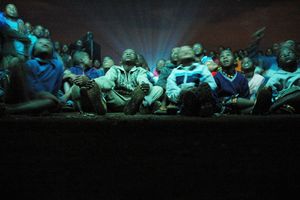
Slum TV_01_Production Image_2007_(c)Slum TV-10
This notion of a participatory counter-narrative is underpinned by two different notions of representation. Firstly it suggests that Slum TV members, being from Mathare, know the neighbourhood better and hence can represent it with a greater degree of fidelity and refined sense of nuance. This then implies that there is a stable, agreed upon and autonomous meaning that exists in Mathare, and that as the Slum TV members are close to Mathare, they are also proximal to this ‘essential’ meaning.(22) But what are the agreed upon meanings in Mathare? If we return to the anecdote about the indistinguishable nature of the criminals and the police, both are armed, protect those who conform to their sense of justice and punish those who transgress it. There is no shared territory of meaning at all so what would be an authentic counter- representation? Just because Slum TV members were more knowledgeable about the environment of Mathare does not mean that their perspective was more authentic, or closer to an essential meaning. So rather than correcting an incorrect representation, it is more accurate to say that Slum TV proposed an alternative representation of Mathare within a broader media ecology.
Of critical importance is that this alternative representation of Mathare was authored by young men and women from the neighbourhood. Hence Slum TV engages in the fundamentally political project of representation—representing individuals from Mathare, as authors and subjects in the Slum TV material. Slum TV was both about the representation of a reality, Mathare, but also about the representation of an identity and taking ownership of that representation. Understanding the project in this light reframes the participatory gesture of Slum TV as one of catalysing potential political agency. It was precisely this potential for political representation that we saw as lacking in the ‘media for development’ and ‘edutainment’ projects in and around Mathare and the Eastlands. For example, by predefining content along the lines of policy-reform, capacity building and awareness change, projects such as Development Through Media (DTM) circumscribe editorial decisions and remove the possibility for participants to freely represent themselves, their wishes, their desires and their identity.(23)
Slum TV Content
Giving editorial control to the Slum TV members resulted in a project that opened up the possibility for a form of political representation. Nevertheless, if we look at the actual content that Slum TV produced at this time (2007-2011) it does not propose a very different representation of Mathare to the previously existing, dominant representations, nor to the content produced by our nemesis, the ‘media for development’ organisations. In fact, it was intriguing which topics Slum TV members proposed to document.
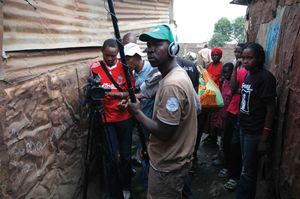
Slum TV_01_Production Image_2007_(c)Slum TV-13
Typically someone would raise their hand and say “I would like to make a film about Water and Sanitation” or “How about a film about HIV/AIDS?” or “Let’s make a film about the Girlchild”. I was amazed at the way these suggestions were formulated. Nobody suggested making a film about the stinking, polluted and plastic bag-clogged Mather river or their neighbour who used blackmarket antiretroviral medicine to feed his chickens or how the boys in their family could go to secondary school and the girls could not.(24)
The members proposed these topics as capitalised issues, adopting the rhetoric of the Development Aid industry in what seemed to be an uncritical assimilation of a language and a set of values. This is what Slum TV initiators described as the NGO aesthetic, a way of framing and representing Mathare as a site of suffering and charity, which is at the same time a space of hope and resilience.(25) The role of NGOs in Kenya and Africa is complex and convoluted, and not being a developmental economist, I am wary to comment on their broad mandate or the efficacy of what is undoubtedly a heterogeneous sector. But as a visual artist I feel I can engage with a tendency amongst NGOs to employ specific representative tropes. This is clearly evidenced in still and moving-image employed by organisations such as Save the Children, Oxfam and Unicef.(26) But perhaps the clearest and most explicit manifestation of this representation can be seen in the choice of NGO logos that, by their nature, distil their ideology. Names such as Hope, Concern, Mercycorp and Tearfund are abundant, as are variations of the map of Africa; as a biblical head crying a tear of blood (Baptist Aids Response Agency in Africa), as a child looking expectantly up to an adult (Hope for African Children Initiative) and as the continent sheltering under an umbrella (ARSO).(27) This discourse and these representations are ubiquitous in Nairobi.(28)
The point being that part of the reason we had developed a collective and participatory structure to enable members to make films about what they chose to, was to try and challenge, nuance and refute this dominant narration of Mathare as purely a space of poverty, crime and suffering. Yet the Slum TV members seemed to be reiterating and reinforcing it. On top of this, the other main corpus of material produced by the members were ‘positive stories’, which were also prevalent in the NGO representations.(29) Typically this would be about a character overcoming challenges to do something extraordinary.
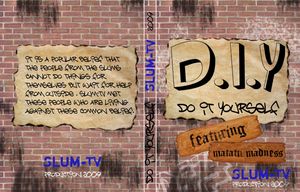
Slum TV_02_DVD Cover_2007_(c)Slum TV-17
‘Home Made Toys’ shows the work and process of a craftsman who uses scrap material and basic tools to create intricately-detailed model trucks, aeroplanes and cars as toys for children.(30) It is a beautifully shot piece, with careful attention paid to the detail and texture of his craft, but to me it seemed to omit a wealth of intriguing details. As the main dumpsite was controlled by one of the main gangs, Mungiki, how did the craftsman get his material, did he have to deal with them? What about all the equipment in his workshop? How was this secured? Did he have to pay security fees to someone or a group to ensure he was not robbed? Who bought these toys? Who brought him customers? How was the commission negotiated?
Not one Slum TV story explored the social problems of Mathare. The complicated network of neighbours, gangsters, police and community groups, which was essential to interface on a day-to-day basis, were just not addressed by the members. And there were ample opportunities and connections to do so. The Slum TV office was directly opposite ‘Nigeria’ the centre of drug trade and drug abuse in Mathare, some of the members even had contacts within this network, yet nobody ever proposed a story about it.(31) The example of Nigeria is extreme, and could also have been dangerous for the members, but it makes evident that even in situations where Slum TV was physically close, and had connections with stories of social malaise in Mathare, they opted not to represent them in the Slum TV moving-image material.
Our reaction as initiators was to abandon the position of being invisible facilitators and adopt an instigating role. We started titling the newsreels, such as ‘The DIY Newsreel’ or ‘The Superlative Newsreel’. These framings, and provocations, worked very well as a strategy for triggering alternative content. The scope of the clips expanded dramatically, featuring everything from a eulogy to the fastest matatu driver, to a tongue in cheek competition about the smartest child in Mathare.(32) But it was a clear departure from the position of enabling Slum TV members to make the content that they wanted to. This was more active and perhaps intrusive.
At the time this really concerned me as I was worried that I was shaping the moving image material, although it purported to be produced by the Slum TV members. Was this true participation if we were framing what content could be made? To try and reflect on this question of power dynamics I wrote obsessively, for publication, in correspondence and in private journals.(33) This process of reflexivity and self-criticality was a critical phase in becoming aware of the dynamics of the project.
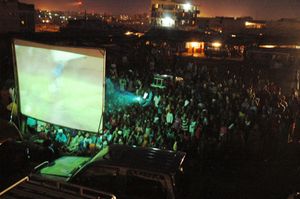
Slum TV_01_Production Image_2007_(c)Slum TV-8
However, if it did not exist in parallel to time spent with the project and with the members, for example, if I was writing whilst in Europe, then I observed that I became entrenched in my positions. It was vital to write and to experience. Through this process of back and forth I started to develop a sensibility to notions of agency, the extent to which it is not always immediately palpable, and how it is filtered, mediated and complicated by notions of identity.
Practitioners of language
“Garbage littering is a health hazard in our community. Lack of efficiency and accountability by the local authority has led to garbage littering all over. In efforts to clean our environment, different stakeholders and different companies take part. We talked to a few of the many who participate in the cleaning of the environment who believe that garbage littering can cause diseases, among other things”.(34)
“Health hazard”, “Lack of efficiency”, “accountability”, “stakeholders”; the quote above reads like a litany of key buzzwords in the language of the Development industry. This seemed to be a striking example of the pervasiveness of the Development rhetoric and the extent to which young people in Slum TV had assimilated and absorbed a language which cast their own surroundings in a specific discourse of suffering and need. But what if, rather than being defenceless in the face of this language, Benson was performing this language?
This quote makes much more sense if we understand it as appropriation rather than as blind pastiche. Is this a knowing performance of what, in the context of Mathare, is a language of power? Or is it rather an uncritical assimilation of the language of the Development Aid industry? I think it most likely a combination of the two, a conscious usage of familiar buzzwords combined with the not so conscious absorption of a very specific discourse about rubbish and the environment. But Benson only uses this specific language when he addresses the camera. When he interviews characters in the clips he speaks in Sheng. It is clear that a specific vocabulary has been consciously employed and there is a clear decision as to when this language is used.
As de Certeau frames it, Benson “practises” the language of the Development industry; it is a form of capital that he operates and controls.(35) This notion of Benson, and the Slum TV members, as practitioners of language effected a Copernican shift in my perspective on the relationship between the Slum TV project and the environment within which it was located. Acknowledging the members as individuals that purposefully used a language was to see them as agents in, and of, their own representation rather than as casualties of a system not of their own making.
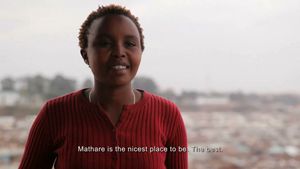
Slum TV_01_Production Image_2007_(c)Slum TV-15
By practising the NGO rhetoric, Slum TV members reminded me that we were always and already located within a complicated field of social relations that existed prior to the advent of the Slum TV project. Slum TV members used the project not to counter abstract representations of Mathare, but to articulate, and negotiate with, an ongoing series of relational and personal representations.
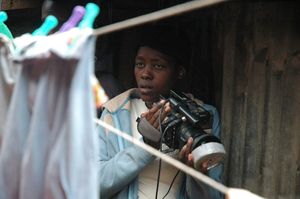
Slum TV_01_Production Image_2007_(c)Slum TV-11
--
- Mathare Valley has been populated since before the Second World War. At Kenya’s independence in 1963 the population was counted in the thousands and it has grown steadily ever since. Nevertheless, on many maps of Nairobi, including Google maps, there is a cartographic void where Mathare Valley is located. https://goo.gl/ maps/w6Krcw9JkJt (Feb 22, 2018). See Jens C. Andvig and Tiberius Barasa, A Political Economy of Slum Spaces: Mathare Valley (Oslo: Norwegian Institute of International Affairs, 2014), https://brage.bibsys.no/ xmlui/bitstream/handle/11250/277609/ NUPI+WP-838-Andvig.pdf?sequence=3 (Feb 23, 2018), p 46.
- The population of Mathare, as with many slums, is difficult to estimate as many of the residents are either unwilling, or unable, to be registered. During the time I was working there regularly (2007-2011) most people 4 referred to a number of about 600,000. See, for example, ‘About Mathare Slums,’ https://matharesiokenya.wordpress.com/ about-mathare-valley-slums/ (February 22, 2018). However, the National Census in 2009 put the figure at 87,097. This discrepancy between the estimate and the official figure led to allegations of miscounting. On the one hand the government was accused of trying to minimise the problem, on the other hand it was suggested that NGOs and aid organisations had a vested interest in an inflated population figure. See Muchiri Karanja, ‘Myth Shattered; Kibera numbers fail to add up’ http://www.nation.co.ke/ News/Kibera%20numbers%20fail%20 to%20add%20up/-/1056/1003404/-/13ga38xz/-/index.html. (November 1, 2014). Since the census, the figure of 200,000 is commonly referred to. See ‘Mathare Population Structure’ http://matharevalley. wordpress.com/2014/02/26/mathare- population-structure/ (February 22, 2018) unsubstantiated figures of 500,000.
- There is a persistent and prevalent local newspaper narrative that Mathare is the most dangerous neighbourhood in Nairobi. But, due to the informal nature of Mathare, and the fact that many thefts, robberies or acts of violence are not reported, it is difficult to obtain crime statistics from Mathare. In fact, the police are often more dangerous than the criminals. For a stereotyped imaged of Mathare see Christabell James Top 10 Most Dangerous Estates in Nairobi - Number 1 will Shock You,’ https://buzzkenya.com/ top-10-most-dangerous-estates-in-nairobi- number-1-will-shock-you/ (February 22, 2018). For examples of police brutality see ‘We demand justice for Alex Mwangi Wangari (19 ) killed by officer Rashid!,’ http://www. matharesocialjustice.org/eje-campaign/we- demand-justice-for-alex-mwangi-wangari-19- killed-by-officer-rashid/ (February 22, 2018).
- A fairly typical example of this journalistic register: ‘Mathare Valley spreads north from Kenya’s capital, a running sore of poverty covered in corrugated iron, where street children use machetes and guns to survive in an environment of murder, rape, TB and cholera.’ Kevin Mitchell, ‘The Pope, Bono and... Mathare United FC,’ http://www. theguardian.com/football/2003/oct/05/ sport.comment2 (November 1, 2014). See also; Faith Nyamai, ‘Scandal of the Children who take Chang’aa for Breakfast,’ http:// nairobinews.nation.co.ke/learners/ (Feb 10, 2014).
- See ‘Restoring Dignity,’ http://www. africanslumjournal.com/restoring-dignity/, (Feb 22, 2018).
- There are some community-based initiatives to counter these various forms of exclusion such as the community mapping project Map Kibera (in Mathare). See; http://mapkibera. org/work/locations/#mathare (Feb 22, 2018).
- Andvig and Barasa, A Political Economy of Slum Spaces: Mathare Valley p. 12.
- Naomi van Stapele, Respectable ‘Illegality’: Gangs, Masculinities and Belonging in a Nairobi Ghetto, Doctoral Thesis, https://pure.uva.nl/ws/ files/2483038/166658_Stapele_thesis_def_ complete.pdf (Feb 23, 2018) pp. 1-14.
- There are various, legendary, policeman in Mathare and the Eastlands that appear to have a free reign to operate a shoot to kill policy. ‘Meet the police officer who BOLDLY executed two teenage gang members in 11 Eastleigh’ https://www.tuko.co.ke/235675- meet-police-officer-boldly-executed-teenage- 12 gang-members-eastleigh.html#235675, (Feb 22, 2018). For a sense of how this is 13 incorporated within local legend see Roomah, http://www.samhopkins.org/roomah.html, (Feb 22, 2018), mins 07:50-8:30.
- The UN Habitat report The Challenge of Slums offers the following ‘Operational definition of Slums’: “inadequate access to water; inadequate access to sanitation and other infrastructure; poor structural quality of housing; overcrowding; insecure residential status”. UN Habitat, The Challenge of Slums: Global Report on Human Settlements 2003, https://www.un.org/ruleoflaw/files/ Challenge%20of%20Slums.pdf (Feb 22, 2018) p. 12.
- This amounts to 16, 32 and 40 Euro cents at todays exchange rate, xe.com (March 12, 2018).
- Mike Davis,Planet of Slums (London and New York: Verso, 2006) pp.15-16.
- I understand Neoliberalism as the extension of a free market logic into all spheres of life, private and public. See Kean Birch, ‘What exactly is neoliberalism,’ https://theconversation.com/ what-exactly-is-neoliberalism-84755 (Feb 23, 2018).
- Slum TV was registered as a Kenyan Trust in 2008 and amended its status to a Non Governmental Organisation (NGO) in 2016. The project is currently managed by Ephantus Kariuki, a former member, and is an accredited organisation, training 20 young people per year in digital video production. For more information see https://www.slumtv. org (February 22, 2018).
- Referring respectively to the works of Rirkrit Tiravanija, Wochenklausur and Santiago Sierra. See Anthony Downey, ‘An Ethics of Engagement: Collaborative Art Practices and the Return of the Ethnographer’, Third Text, 23:5, pp. 594-5.
- I was nurturing an art practice that explored spaces and audiences beyond gallery contexts and often in public space. See ‘The Seduction of Completion’, 577,4 - The Distance Between, https://www.uni-weimar. de/mfa/downloads/577,4%20the%20 distance%20between.pdf (February 26, 2018). pp 48-9. Alex Nikolic had been developing a socially-engaged, emancipatory art practice. See ‘Under the Bridge Beograd’, Postism.org, http://an.postism.org/cv/under-the- bridge-beograd/ (February 26, 2018). Lukas Pusch was developing a series of provocative interventions in the tradition of Vienna Actionism. See Economy Class – Lukas Pusch, http://www.nyartsmagazine.com/economy- class-lukas-pusch/(February 26, 2018). Julius Mwelu was honing a photojournalistic practice. See ‘Julius Mwelu, 22, ‘We are proud of who we are despite where we live’, April 11, 2007, http://www.irinnews.org/ report/71561/kenya-julius-mwelu-22-we- are-proud-who-we-are-despite-where-we-live (February 26, 2018).
- For Thomas Hirschorn Monument series: Michael Rush, ‘ART/ARCHITECTURE; Art That Gives Meaning To Bits of This and That’, OCT. 27, 2002, http://www. nytimes.com/2002/10/27/arts/art- architecture-art-that-gives-meaning-to-bits- of-this-and-that.html (February 26, 2018). For The Battle of Orgreave - http://www. jeremydeller.org/TheBattleOfOrgreave/ TheBattleOfOrgreave_Video.php (February 26, 2018). For Park Fiction - http://urban- matters.org/projectsbyindividuals/park- fiction (February 26, 2018). For Superflex’s internet TV - ‘Superchannel’, http://www. superflex.net/tools/superchannel (February 26, 2018). For Francis Alys’ collective performances - ‘Francis Alÿs, When Faith Moves Mountains, 2002’, https://www. moma.org/collection/works/109922 (February 26, 2018).
- Slum TV members showed a remarkable, albeit often begrudging, tolerance for cases of petty theft by other members. In only 2 cases that I can remember (out of perhaps 50) did members vote to expel the guilty party. Perhaps in a situation of constant financial pressures there is more widespread empathy for why friends might steal from one another. The consequences of not having money are also extreme; failure to pay the rent can result in your house being broken into by the landlord and your belongings removed and left on the road outside. See City of Choice (Trailer), directed by Arne Birkenstock & Sam Hopkins (Cologne & Nairobi: Slum TV & Fruitmarket Films, 2013), https:// vimeo.com/233562703, password ‘mathare’ (February 22, 2018) mins. 08-09:30. Public theft in Mathare is dealt with even more extremely, with regular incidents of so-called ‘mob justice’ in which the thief is beaten, and in some cases killed, by a public crowd. See Edwin Odhiambo, ‘Thug Burned to Death in Mathare 3C Area’, https://gnnkenya. wordpress.com/2015/01/03/thug-burned-to- death-in-mathare-3c-area/ (February 22, 2018)
- Ian Mwangi was starting to manage the accounts from 2009 and by 2012 the entire project was mainly run by former members (Ephantus Kariuki as Project Manager, Beatrice Wanjiku in charge of Finance and Idah Opolloh as head of Training) with assistance from an external Project Manager, Kenneth Wendo.
- The material is collated and screened on a monthly basis in public space in Mathare. Thus it functions like a ‘newsreel’ and affords the slum dwellers a form of local news. Having been screened locally, the content is then uploaded onto the website, which functions both as an archive of this oral history and a means to access a secondary, international audience.” Sam Hopkins quoted by Basia Lewandowska Cummings in ‘Five alternative filmmaking collectives’, http://africasacountry.com/2012/07/ five-alternative-filmmaking-collectives/ (February 22, 2018). After the first workshop in April 2007 we then started theming the newsreels such as The Environment Newsreel (Nairobi: Slum TV, 2007), The Peace Newsreel (Nairobi: Slum TV, 2008), The Water Newsreel (Nairobi: Slum TV, 2009) and The Superlatives Newsreel (Nairobi: Slum TV, 2009). Typically the newsreel would have 5-7 “mini- documentaries” and 1 “drama”, a short acted film by Slum TV. (Nairobi: Slum TV, 2009).
- Karen Allen, ‘Kenyan terror at gang crackdown’, June 8, 2007, http://news.bbc. co.uk/2/hi/africa/6733879.stm (Jan 12, 2018).
- In the words of Stuart Hall, it assumes the problem to be the ‘re’ of ‘representing’. Stuart Hall, ‘Representation and the Media’, https://www.youtube.com/ watch?v=aTzMsPqssOY&t=7s (February 22, 2018) mins. 10:00-12:30.
- See ‘About DTM’, http://dtmafrica.com/ about-us/about-dtm/ (Jan 12, 2019). For a further example of how the discourse of ‘empowerment’ does not involve the constituencies they work with in an empowering manner, see ‘Appropriation of ICTs by young women living in informal slums’, November 24, 2009, http://mediea. ruc.dk/projects/appropriation-of-icts-by-young-women/ (February 26, 2018).
- For the state of Mathare River see ‘Mathare: Slum River Pollution Puts Lives at Risk’, https://rising.globalvoices.org/ blog/2012/08/28/mathare-slum-river- pollution-puts-lives-at-risk/ (February 22, 2018). On chickens being fed Antiretroviral drugs (ARVs) see ‘How Kenyans are misusing antiretroviral drugs (ARVs)’, https://www. kenyaplex.com/resources/10130-how- kenyans-are-misusing-antiretroviral-drugs- arvs.aspx, (February 22, 2018). About 37 the unequal opportunities for secondary schooling, Molly Warrington and Susan Kiragu, ‘”It makes more sense to educate a boy”: Girls ‘against the odds’ in Kajiado, Kenya’, International Journal of Educational Development, Volume 32, Issue 2, pp. 301-309.
- I credit the term NGO aesthetic to Alex Nikolic.
- See ‘Doing Whatever It Takes to Save Every Last Child | Save the Children’, https://www.youtube.com/watch?time_ continue=39&v=Cmtg7v9I2JQ (Jan 13, 2019).
- The experience of the dominant discourse of NGOs in Mathare has led to a series of critical artistic engagements with the logos produced and disseminated by the Non Governmental Organisations (NGOs) in Kenya. See Jennifer Bajorek, ‘Beyond the NGO Aesthetic’, in Social Text 127, pp 93-102. See also ‘Deconstructing Logos - Kimani wa Wanjiru talks with Sam Hopkins’, May 21, 2014, http://www.contemporaryand.com/ magazines/deconstructing-logos-of-non-profit-organisations/ (March 12, 2018).
- For further discussion of this see ‘The Exchange: Sam Hopkins and Michela Wrong on Africa’s New Missionaries’, Dec 10, 2015, https://foreignpolicy.com/2015/12/10/the- exchange-sam-hopkins-and-michela-wrong- on-africas-new-missionaries/ (Jan 13, 2019).
- The term of ‘positive stories’ emerged again and again both from the members in Slum TV, from donors and from journalists that came to feature the Slum TV project. Slum 41 TV as the ‘positive’ representation of Mathare was an extremely persistent image.
- Slum TV, ‘Home Made Toys’, Grassroots Upgraded Newsreel (Nairobi: Slum TV, 2011), https://vimeo.com/260200625 (March 16, 2018).
- Many of the different areas in Mathare were 42 named after foreign countries or cities. As well as Nigeria, there is Kampala, Jamaica, Bosnia, Vietnam and Kosovo. See Melissa Wangui Wanjiru and Kosuke Matsubara, ‘Slum toponymy in Nairobi, Kenya; A case study analysis of Kibera, Mathare and Mukuru’, Urban and Regional Planning Review Vol. 4, 2017, https://www.jstage.jst.go.jp/ article/urpr/4/0/4_21/_pdf (February 26, 2017) p. 36.
- The Superlative Newsreel, (Nairobi: Slum TV, 2009) generated stories from Mathare such as the fastest minibus driver, the best cart- puller, the smartest kid in Mathare. https:// nairobinow.wordpress.com/2009/03/19/ slum-tv-screening-mar-20th-2009-mathare/ (November 8, 2014).
- For example, “Strongly related to this issue of responsibility is, of course, an issue of power relations. How ‘free’ are the decisions of the participants here? To what extent am I unwittingly influencing the outcome of the meetings?” Sam Hopkins, ‘Working Title’ in Slum TV in Belgrade and Novisad, (Belgrade, Anonymous said, 2008).
- Benson Kamau’s voiceover, ‘Garbage collection from our environment’, The Environment Newsreel (Nairobi: Slum TV, 2007).
- Benson’s conception and appropriation of the Development rhetoric, and his positioning of himself in relation to an imaginary, yet seemingly defined, audience, resonate strongly with de Certeau’s notion of enunciation and clearly informs this perspective on how Slum TV members use the language of the Development industry. See Michel de Certeau The Practice of Everyday Life (London and Berkeley: University of California Press, 1984) p. 33.